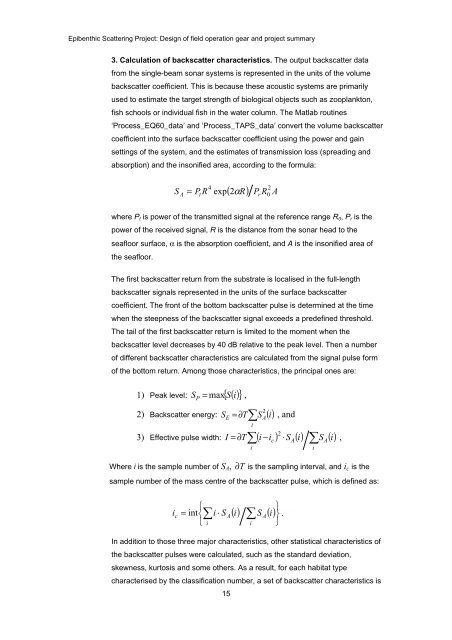Epibenthic scattering project - FTP Directory Listing
Epibenthic scattering project - FTP Directory Listing
Epibenthic scattering project - FTP Directory Listing
Create successful ePaper yourself
Turn your PDF publications into a flip-book with our unique Google optimized e-Paper software.
<strong>Epibenthic</strong> Scattering Project: Design of field operation gear and <strong>project</strong> summary<br />
3. Calculation of backscatter characteristics. The output backscatter data<br />
from the single-beam sonar systems is represented in the units of the volume<br />
backscatter coefficient. This is because these acoustic systems are primarily<br />
used to estimate the target strength of biological objects such as zooplankton,<br />
fish schools or individual fish in the water column. The Matlab routines<br />
‘Process_EQ60_data’ and ‘Process_TAPS_data’ convert the volume backscatter<br />
coefficient into the surface backscatter coefficient using the power and gain<br />
settings of the system, and the estimates of transmission loss (spreading and<br />
absorption) and the insonified area, according to the formula:<br />
4<br />
2 ( 2 R)<br />
P R A<br />
S A = Pt<br />
R exp α r<br />
where Pt is power of the transmitted signal at the reference range R0, Pr is the<br />
power of the received signal, R is the distance from the sonar head to the<br />
seafloor surface, α is the absorption coefficient, and A is the insonified area of<br />
the seafloor.<br />
The first backscatter return from the substrate is localised in the full-length<br />
backscatter signals represented in the units of the surface backscatter<br />
coefficient. The front of the bottom backscatter pulse is determined at the time<br />
when the steepness of the backscatter signal exceeds a predefined threshold.<br />
The tail of the first backscatter return is limited to the moment when the<br />
backscatter level decreases by 40 dB relative to the peak level. Then a number<br />
of different backscatter characteristics are calculated from the signal pulse form<br />
of the bottom return. Among those characteristics, the principal ones are:<br />
1) Peak level: SP = max{<br />
S()<br />
i } ,<br />
2) Backscatter energy: S = ∂T<br />
2<br />
S () i , and<br />
E ∑ A<br />
i<br />
2<br />
3) Effective pulse width: I = ∂T∑(<br />
i −ic<br />
) ⋅S<br />
A()<br />
i ∑SA()<br />
i<br />
Where i is the sample number of SA, ∂T is the sampling interval, and ic is the<br />
sample number of the mass centre of the backscatter pulse, which is defined as:<br />
() () ⎬<br />
⎭ ⎫<br />
⎧<br />
ic = int⎨∑i<br />
⋅ S A i ∑ S A i .<br />
⎩ i<br />
i<br />
In addition to those three major characteristics, other statistical characteristics of<br />
the backscatter pulses were calculated, such as the standard deviation,<br />
skewness, kurtosis and some others. As a result, for each habitat type<br />
characterised by the classification number, a set of backscatter characteristics is<br />
15<br />
i<br />
0<br />
i<br />
,


